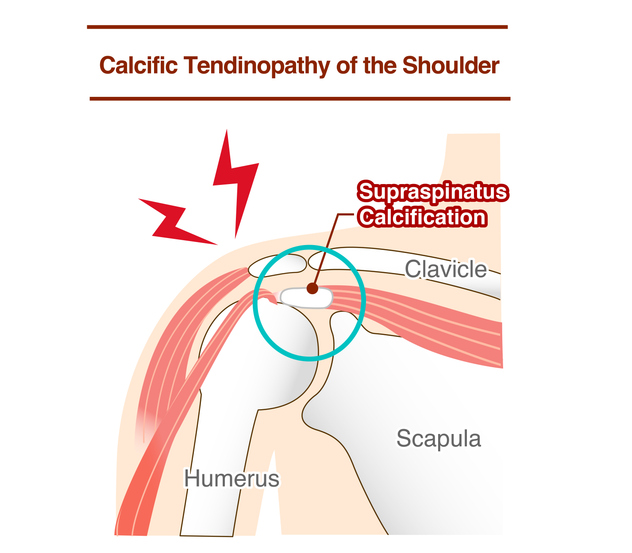Rotator cuff calcific tendinopathy of the shoulder is a condition in which calcium deposits build up within the rotator cuff tendons- usually near to where they attach to the humerus ( upper arm bone).
Calcific deposits seen on Ultrasound scanning of > 1.5cm in diameter tend to be more painful than those of < 1cm in diameter. Deposits within the supraspinatus tendon tend to be more painful.

Signs and Symptoms
- Pain at night causing loss of sleep.
- A constant dull ache throughout the day.
- Exacerbated with arm movements and repetitive actions.
- Localised tenderness and swelling of the affected tendon.
- Reduced shoulder movement and a feeling of stiffness
- Loss of arm function in daily life
- Most common in females between the ages of 50-70 years.
- Being overweight or obese
- Those with metabolic conditions such as diabetes
- Being a smoker or ex-smoker.
- Occupations requiring repetitive shoulder movements eg desk- based occupations, production line workers and cashiers.
Treatment
Conservative Physiotherapy rehabilitation manages the condition like a non- calcific rotator cuff tendinopathy which involves graded loading to stimulate healing, restore function and build strength in the affected structures respecting pain.
Early Stage
In the initial stages, the focus of treatment is to reduce the pain levels, maintain shoulder range of motion and function. Gentle shoulder range of motion and isometric muscle exercises are recommended to help reduce the pain. The exercises should be performed so as not to exceed 3/10 pain on a perceived pain scale.
Intermediate Stage
As pain and range of shoulder motion improves, the emphasis of treatment shifts to paced, progressive loading of the rotator cuff tendons to improve strength and stability. The exercises are again performed within the tolerable levels of discomfort.
The exercises are now done 2-3 times per week to fatigue with a rest day between sessions to allow the muscle and tendons to recover and build strength. The exercises will be tailored toward your everyday functional movements and load. It is important to balance the exercise programme with how much you are physically using the arm at this stage.
Late Stage
Once you are pain free and feeling stronger, you can enter this stage of further strengthening to build resilience in the affected tendons, shoulder complex and body as a whole. The exercises should be challenging to perform, novel in their stimulus and aligned with your desired return to sport. Again they are performed 2-3 times per week with rest days. The aim is to lower the likelihood of future occurrences. Keeping within pain tolerance of 3/10 still applies.
Persistent Shoulder Pain
If the pain persists Extracorpeal Shockwave Therapy can be helpful in reducing the pain and breaking down the calcium deposits. ESWT can be performed by your therapist alongside your rehabilitation programme. On average 3-6 sessions are required depending on how chronic the condition is. ESWT is none invasive and without side effects. Alternatively a specialist doctor can perform dry needling (barbotage) to the calcium deposits or remove them via arthroscopic surgery.
